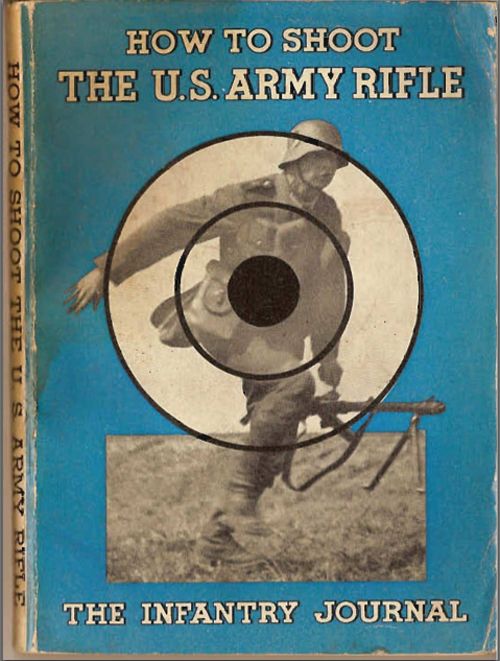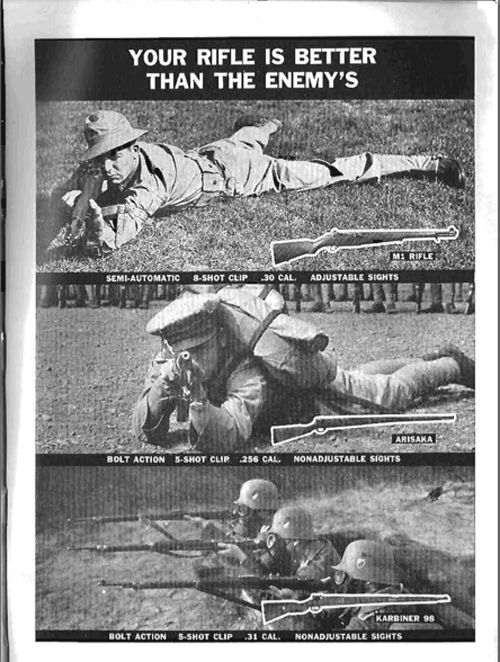
Courtesy
200
I recently ran across a fascinating copy of the U.S. Army’s “How to Shoot The U.S. Army Rifle” handbook, published in 1943.
This book, subtitled The Infantry Journal, was prepared by First Lieutenant Arthur Goodfriend, creator of the Army’s graphic portfolio on rifle marksmanship. The acknowledgements suggest how important the topic of shooting well was back then.
Involved in the project were the editors of Life magazine, “who loaned the cream of their staff to the Army for this project.” Also credited was Life photographer, Gjon Mili, “whose repetitive flash camera dissects the rapid-fire positions.”
Also receiving notice were the Engineer School, Fort Belvoir, Virginia; The Infantry School, Fort Benning, Georgia, where the doctrine was shaped and pictures taken, and “to Brigadier General C. R. Huebner, General Staff Corps, Director of Training, Services of Supply, who initiated the preparation of the official training portfolio upon which this book is based, and who gave it the benefit of his long experience gained on battlefields abroad and in training camps at home.”
What’s refreshing about the Journal is how clear and unaffected its non-politically-correct prose is. For example, “The last war proved that if you hit a German in the right place with a caliber .30 rifle bullet, he falls over dead. This is also true in this war. It applies, moreover, to Japs as well as to Nazis.”
Continuing, the Journal opines, “The U. S. Army Rifle—be it the M1903 (Springfield), M1917 (Enfield), or M1 (Garand)—has the range, caliber, power, and accuracy to kill Nazis and Japs. All that is required is a soldier well enough trained in rifle marksmanship to hit the enemy in the right places.”
Obviously, the U. S. Army believed, and believes, in this training. Its rifle marksmanship course was the most thorough in the world. In WWI, the deadliness of American marksmanship amazed both our Allies and our enemies.
Likewise, in WWII, reports from far-flung battlefields revealed that the hours of marksmanship training were not spent in vain.
As the Journal noted, “Deadly marksmanship depends on correct shooting habits. In stress of battle, you must do the right things without thinking about them. You must know the correct sight picture. You must take a rock-steady position. You must squeeze the trigger. You must shoot rapidly. And all the while, your sights must be correctly set for range, wind, and weather.”
How to do these things the right way is shown on the Journal’s pages, with pictures and text taken from the U. S. Army’s graphic portfolio on rifle marksmanship.
The Infantry School for the semiautomatic M1 rifle was, and is, a method that enables you to get the most out of any rifle you may ever have to shoot. It said, “Put aside your own ideas on rifle shooting for the duration of the war. Where life and death, victory or defeat, depend on the result, it is wise to follow this method. It is based on countless hours of test and trial, on the range and the battlefield.”
Shooters of today can see in its pages that firing on the range meant more bull’s-eyes, lessons which when translated to the battlefield, “will cause many a Nazi and Jap to echo the words of that German in the last war who, dying, wrote: “God save us from these Americans. They shoot like devils…. They are the best marksmen in the world.”
Over the next few weeks, I’ll gather excerpts from the handbook and put them here on GunReports.com. They’re fantastic reading, not only because of the technical prowess of the material, but also because of the unstinting look at what shooting in war situations requires.
Here’s the first installment, from the chapters, “Today—the Bull’s-eye. Tomorrow—The Enemy,” and “Your Rifle Is Better Than The Enemy’s”.
TODAY—The Bull’s-Eye, TOMORROW—The Enemy
Today’s bull’s-eye will be a well-trained, well-armed Jap or Nazi tomorrow. You hit him. Or you miss. For that reason, there’s no such thing as shooting that is about right. It is either perfect-or it is wrong. Your life depends upon it.
In camp, you shoot at a fixed target. On the battlefield, the target moves. You must learn to hit the first-before you can hope to hit the second. By learning right shooting habits-by constant practice-every man can learn to shoot.
It seems hard at first. Later, when your body limbers up- when you learn the rules of good marksmanship-it becomes easier.
Your Rifle Is Better Than The Enemy’s
The M1 rifle costs about $80 to build. It is semiautomatic. It has an 8-shot clip. It has adjustable sights. It can shoot straighter and faster than standard rifles issued to the Japs and Germans.
The M1903 (Springfield) proved itself against the Germans in the last war, and is still a masterpiece of rifle construction today. It is a high-precision weapon, with adjustable sights and an effective range of 600 yards.
The Jap has an Arisaka rifle. It has a shorter range than the M1 and M1903. It has a lighter bullet. It has no windage scale. It is only fairly accurate beyond 500 yards.
The Germans are equipped with the Karbiner 98. Like our Springfield it is bolt-operated, with a 5-shot clip. But it has no windage or elevation. It hasn’t the accuracy of our American rifle.
Your rifle should give you an advantage over the enemy. But actually, your rifle is no better than the man who shoots it. If you can’t shoot your rifle accurately, you might just as well meet the Axis with your bare fists.

US Army
200
Here’s a list of the book’s chapters:
- Today—the Bull’s-eye. Tomorrow—The Enemy
- Your Rifle is Better than the Enemy’s
- Six Steps to Perfect Marksmanship
- You Are Both a Coach and Pupil
- Sighting and Aiming
- Why There is Only One Correct Sight Picture
- First Sighting and Aiming Exercise
- Clean and Blacken Your Sights
- Second Sighting and Aiming Exercise
- Third Sighting and Aiming Exercise
- The Rock of the Marne
- How to Adjust the Loop Sling
- How to Tighten the Loop
- A Tight Sling Means a Steady Rifle
- Take Up the Slack
- Hold Your Breath While Aiming
- Support the Rifle ‘With Your Bones’
- The Prone Position
- The Sandbag Rest Position
- The Sitting Position
- The Kneeling Position
- The Squatting Position
- How to Adjust the Hasty Sling
- Sling Goes Well Up on Arm
- Final Phases of the Hasty Sling
- The Standing Position
- What’s the Matter With This Picture?
- The Best “Marks-Man” Wins
- Squeeze-Don’t Jerk
- Call Your Shots
- Your Life-Or His
- Prone Position-First Method
- Skirmisher’s Method
- Prone Position-Rushing
- The Sitting Position
- The Kneeling Position
- Cover to Cover/Up
- Cover to Cover/Down
- Loading in Four Positions
- First Rapid Fire Exercise
- Second Rapid Fire Exercise
- Third Rapid Fire Exercise
- Will You Kill These Nazis?
- This is the Rear Sight
- Windage Knob
- Elevating Knob
- Wind Changes Path of Bullet
- How to Correct Sights for Wind
- Windage to Allow for First Shot
- Your Rifle is Like Your Girl
- How to Zero the Rifle
- Adjust the Sights
- Adjust the Elevating Knob
- Sight Changes
- Wind Gauge and Elevating Drum
- And Now You Shoot for Record
- Answers to Problems





























